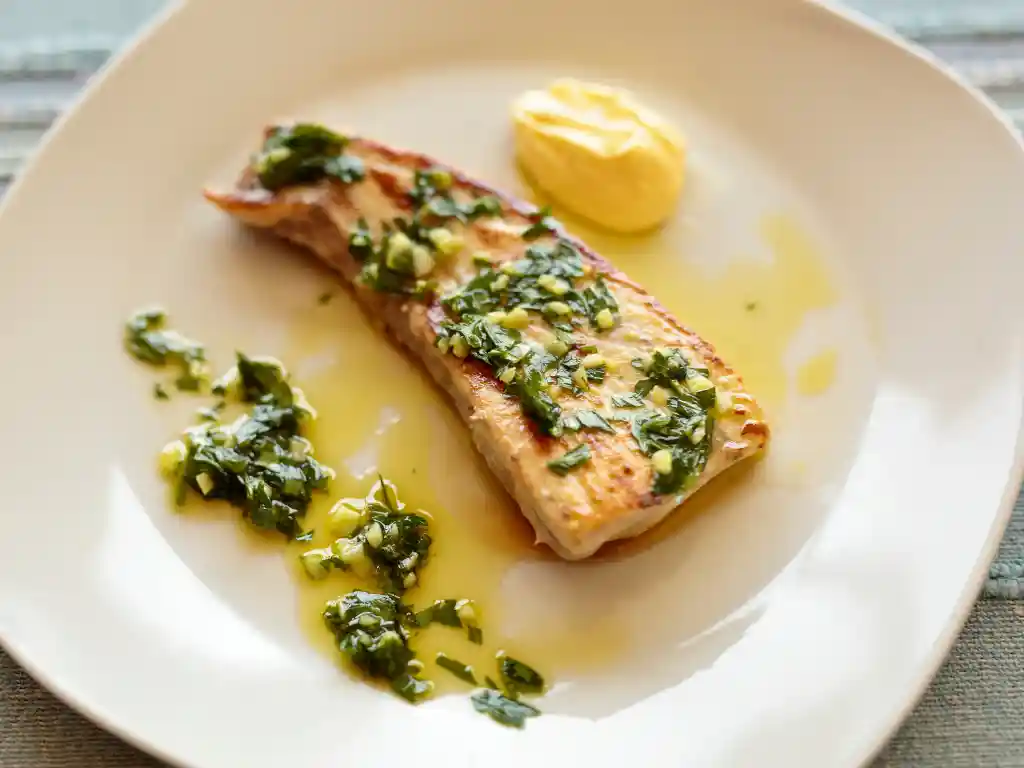Introduction
I still remember the day I decided to buy swordfish at the local market. The fishmonger held up a beautiful piece of fresh fish, and I was drawn to its firm texture. I had heard how swordfish has a mild flavor—less “fishy” than other types—and I wanted to try something new. Standing there, I imagined a simple marinade with olive oil, a squeeze of lemon juice, and a sprinkle of herbs that could bring out its gentle taste.
On my way home, I thought about different cooking methods. A friend had once mentioned a baked swordfish recipe, but I knew my favorite way would likely be the grill. The smoky aroma on a warm evening felt too tempting to ignore. I pictured the fish sizzling over high heat, those grill marks searing in, while I stayed careful not to overcook it. Because of the sturdy texture of swordfish, I hoped it wouldn’t end up falling apart.

That night, I pulled out my paper towels, patted the fish dry, and seasoned it lightly before letting the marinade soak in. Within minutes, I was ready to cook. The result was tender, moist, and flavorful—proof that a simple approach can deliver an incredible swordfish steak any night of the week.
Table of Contents
Key Benefits
When you choose this grilled swordfish steak recipe, you’ll enjoy several advantages:
- Easy Preparation: Some seafood dishes feel intimidating, but swordfish is much simpler. Because it has a robust structure, it’s easier to handle on the grill than many delicate fillets. This is especially convenient if you’re newer to grilling.
- Nutrient-Rich: Swordfish is often praised for its protein content and healthy fats. Adding it to your meal rotation can expand the range of nutrients in your diet, especially if you regularly rotate your seafood choices.
- Versatile Flavor: With its mild flavor, swordfish can be matched with many seasoning profiles—from tangy lemon garlic to bright herbal blends. You can stay classic with lemon butter or explore bolder styles with red pepper flakes or caper additions.
- Time-Saving: This swordfish meal doesn’t take long to cook. You can finish it on the grill within minutes, making it perfect for a quick weeknight dinner or a low-stress lunch when you have guests. The short cooking time also ensures you won’t overcook the fish, preserving its tender texture.
- Healthy Option: Many people like swordfish because it’s generally lean, making it a good choice if you want a hearty but less oily fish. With a light marinade and fresh finishing touches, you get a clean, bright taste.
With these benefits in mind, it’s easy to see why you might reach for swordfish next time you want to cook something special but still keep things straightforward in the kitchen.
Ingredients
Below, you’ll find a simple list of ingredients for this flavorful dish. Remember, you can adjust amounts to your liking, but these measurements work well if you want balanced seasoning. This recipe takes about 20 minutes to prep and about 8–10 minutes to grill.
- Swordfish steaks (about 1-inch thick): Aim for about one steak per person. As always, buy steaks that appear fresh, with no dryness on the surface.
- Kosher salt: You need a little for the marinade and a small sprinkle before grilling.
- Black pepper: Freshly ground is best. You’ll use it with salt as the main seasoning.
- Crushed red pepper flakes: Add a pinch for mild heat, or more if you like a bit of spice.
- Minced garlic: About one garlic clove worth, finely chopped.
- Olive oil: Use about two tablespoons of either standard or extra virgin olive oil (if you want more depth in flavor).
- Fresh lemon juice: Squeeze about one tablespoon. This brightens the swordfish.
- Lemon zest: Grate a bit from the same fresh lemon for extra brightness.
- Parsley or fresh parsley: Minced, for garnishing. Optional, but it adds color and a garden-fresh taste.
- Optional: Caper for a tangy accent.
- Optional: Additional herbs or a lemon-herb blend, which can turn into a fresh lemon-herb sauce if you whisk it with olive oil and seasoning.
You can also keep a bit of lemon butter on hand if you prefer a richer finish. Some folks say that swordfish needs sauce to avoid dryness, though it’s fine on its own if cooked properly.
Instructions
H3: Step 1 – Prep the Swordfish
- Pat the swordfish steaks dry: Take paper towels and gently dab away any excess moisture on the surface. This helps the marinade and seasonings adhere well.
- Let them come to room temperature: Leave the steaks on a plate for about 15 minutes so that they cook evenly later. If the fish is too cold, the exterior may cook faster than the interior.
H3: Step 2 – Make the Marinade
- Grab a small bowl: Combine two tablespoons of olive oil (or extra virgin olive oil), one tablespoon of fresh lemon juice, the minced garlic, about half a teaspoon of kosher salt, a pinch of black pepper, and a sprinkle of crushed red pepper flakes if you like heat.
- Juice the lemon first, then grate a little zest and mix it in. The zest adds more bright character, while the juice adds tang.
- Optional but recommended: Stir in a teaspoon of caper or fresh chopped herbs like parsley. You could also drizzle in a bit more olive oil if you want a looser blend.
- Set aside to marinate: You can place the marinade in the fridge for a few minutes if you’re not ready to grill immediately.

H3: Step 3 – Marinate the Swordfish
- Place the swordfish steaks in a shallow dish or large resealable bag.
- Pour the marinade over the fish, making sure each side is coated. If you use a bag, seal it and gently move the fish around to distribute the marinade.
- Marinate for about 15 minutes. You do not need a long soak since swordfish absorbs flavor quickly. Going too long can sometimes alter the texture.
H3: Step 4 – Heat the Grill and Prep the Grates
- Heat the grill: Turn it to medium-high heat. This ensures you get a good sear without burning.
- Oil the grill grates with a paper towel lightly dipped in oil to reduce sticking. Some folks skip this step, but it’s helpful when dealing with fish.
- Wait until the grill is fully preheated so you can sear the fish quickly.
H3: Step 5 – Grill the Swordfish
- Place the swordfish steaks on the grill. They should sizzle upon contact if your grill is hot enough.
- Cook the first side for about 3 minutes or until you see distinct grill marks forming. Then, flip the swordfish carefully.
- Continue to grill the fish on the second side for another 3–5 minutes, depending on thickness. The key is not to overcook it. You want an internal temperature of about 145°F in the center of the fish, though some prefer just a hair under that for the best flavor.
H3: Step 6 – Finish Cooking and Serve
- Once it reaches your preferred doneness, transfer the swordfish to a plate. It’s important to let rest for a minute or two, just like you would with steak, so the juices redistribute.
- Taste and adjust seasoning if needed. A bit of lemon or a drizzle of fresh lemon-herb sauce can brighten it further.
- If you like to serve it with a richer element, a spoonful of lemon butter can be added at the end. This is completely optional but satisfying.
That’s it! You now know how to cook this swordfish on the grill in a few easy steps, ensuring it remains tender and never fishy
Pro Tips and Variations
- Avoid Overcooking: Watch the time carefully. It’s easy to overcook fish, and swordfish can become dry if left on the grill too long. The moment you see it flake easily and appears opaque, your fish is done.
- Marinade Intensity: If you love a tangy flavor, feel free to marinate for closer to 20 minutes. That said, you don’t want the acid to break down the surface too much.
- Keep It Moist: If you find your grill especially hot, move the fish to a slightly cooler spot to finish cooking gently.
- Baked Swordfish Recipe Variation: For a simple oven approach, preheat your oven to 400°F, lightly oil a baking dish, and put the marinated fish in for about 10–12 minutes. Turn once halfway through. This method preserves the mild flavor but lacks the smokiness you get when you grill swordfish.
- Lemon-Garlic Variation: Keep some extra lemon garlic mixture on the side. Brush it onto the fish just before removing from the heat. This enhances the aroma and adds a final burst of acidity.
- Bold Add-Ons: If you like spicier dishes, increase the red pepper flakes or add chopped chili peppers to your marinade. If you’re craving more tang, toss in an extra teaspoon of caper or even some chopped olives.
- Lemon-Herb Twist: For a fresh lemon-herb sauce, mix extra virgin olive oil with minced basil, parsley, or thyme, along with a squeeze of fresh lemon juice. Whisk until combined and drizzle over the grilled fish. This quick mixture can be stored in the refrigerator for a few days, and it works well on salads too.
- Preventing Fishy Odor: Ensuring you dry with paper towels and add citrus or vinegar-based marinades can help. Keep a clean surface while prepping and store your swordfish properly if you are not cooking right away.
Try these tips to make your cook time stress-free and your swordfish steak mouthwatering.
Serving Suggestions
H3: Light Side Dishes
- Green Salad: A crisp salad with tomatoes, cucumbers, and a light vinaigrette helps balance the richness of swordfish. The crunchy greens and bright dressing create a fresh contrast.
- Mediterranean Orzo Salad: A bowl of orzo pasta mixed with olives, feta cheese, diced cucumbers, and a lemon-olive oil dressing pairs excellently with swordfish. It has a gentle tang that blends beautifully with the fish.
- Grilled Vegetables: Since you already have your grill running, you can add some zucchini, bell peppers, or onions. They cook quickly and taste wonderful beside your swordfish.
H3: Heartier Complements
- Crusty Bread: Perfect for those who want to soak up the delicious leftover juices or extra sauce.
- Roasted Potatoes: If you want a more substantial meal, seasoned potato wedges or baby potatoes roasted with salt, pepper, and herbs give the dish more heft.

H3: Sauces and Toppers
- Caper and Herb Mix: A small dish of chopped parsley, capers, and a pinch of lemon zest can be served on top to add extra brightness.
- Lemon Butter: A spoonful melted on top of hot fish is decadent. It seeps into the surface, enhancing each bite.
- Fresh Lemon-Herb Sauce: Whisk together extra virgin olive oil, herbs, lemon juice, and a dash of salt. It’s light, bright, and complements the fish perfectly.
With these serving ideas, you can serve the swordfish in a way that fits your personal preferences. Whether you go for a summery salad or a bowl of comforting starches, the best flavor arises when the fish remains the centerpiece, and the sides highlight its natural taste.
Conclusion
If you’ve been looking to cook a fast, tasty seafood dish, this is the swordfish recipe to try. From selecting fresh fillets at the market to seasoning and grill techniques, the process is straightforward and takes minimal time. When you handle the fish gently, pick bright flavors like fresh lemon or lemon garlic, and stay attentive to cooking times, you’ll avoid dryness and draw out the best of this meaty fish.
Remember, whether you grill or bake, swordfish is done when it turns opaque and flakes easily under gentle pressure. Stick to quick methods, keep your heat at medium-high heat, and season assertively—but not heavily—so you do not overshadow the natural taste. Finally, a good marinade, especially one featuring a bit of citrus or caper, can be the finishing touch that brings the fish to life.
Whenever you’re craving a dinner that feels a little special but still manageable on a busy night, this grilled swordfish steak approach is a winning pick. From the snap of those grill marks to that tender, juicy center, you’ll find that swordfish stands out among other fish choices. Try it at your next cookout, or keep the steps bookmarked for a quick and healthy midweek meal. A final drizzle of fresh lemon-herb sauce or lemon butter can send it over the top.
FAQs
Q1: What is the best method of cooking swordfish?
A: While there is no single method that applies to everyone, many people prefer grilling. It locks in moisture, adds smoky flavor, and creates a lightly charred surface. However, you can also bake or pan-sear it. Choose whichever style suits your taste and kitchen setup.
Q2: What should I season swordfish with?
A: Salt, pepper, olive oil, and a bright element like fresh lemon juice or vinegar are popular starting points. Consider adding herbs like parsley or thyme, and a little garlic to keep things balanced. If you want extra zing, stir in red pepper flakes or caper.
Q3: What seasoning is best for swordfish?
A: A lemon-herb blend is one of the top options because it pairs well with the mild flavor of swordfish. Something as simple as kosher salt and black pepper with a squeeze of lemon and a few herbs can bring out the best in this fish. Just remember not to overcook it so your seasonings remain fresh and bright.




